 Just like the human population, obesity is a huge problem in pet dogs. The Association for Pet Obesity Prevention (APOP) conducted the First National Pet Obesity Awareness Day in 2007. The findings were alarming, 43% of all dogs assessed by veterinary care providers were overweight or obese. We are, literally killing our dogs by making them fat. I, on a daily basis, witness firsthand the gradual deterioration of our pets health. I see puppies as clients for the first time, and several years later these same puppies waddle into my shop looking like stuffed sausages.
Just like the human population, obesity is a huge problem in pet dogs. The Association for Pet Obesity Prevention (APOP) conducted the First National Pet Obesity Awareness Day in 2007. The findings were alarming, 43% of all dogs assessed by veterinary care providers were overweight or obese. We are, literally killing our dogs by making them fat. I, on a daily basis, witness firsthand the gradual deterioration of our pets health. I see puppies as clients for the first time, and several years later these same puppies waddle into my shop looking like stuffed sausages.
From how veterinarians are taught and practice nutrition to manipulation on the part of dog food manufacturer’s, from our society’s insatiable urge to include food into every act of life to a subtle shift in what we perceive as normal weight-all of these factors have created an epidemic of obese pets. And with this extra weight comes a greater risk for crippling arthritis, respiratory disease, diabetes and lives cut short. I have witnessed firsthand how exercise and and food can transform a life.
Conventional veterinarians are taught how to treat disease, not prevent them. They are not taught to view food as medicine or how nutrition can preserve health. Most of their nutritional training is driven and funded by pet food companies. Because of this reason, I have vowed to discuss the diet and lifestyle of pets with anyone who will listen.
Many pet owners do not read the labels of their dogs food. They believe that they are buying healthy food, when what they are really buying is loaded with sugar and fat which actually changes their dog’s brain chemistry and addicts them to overeat. Pet food labels can be challenging to interpret, so therefore they rely on word of mouth recommendations from pet stores, breeders and veterinarians, many of whom know little beyond the company’s flashy brochures and marketing.
You have the power to make changes that will help your pet live a longer, happier, healthy life. Addressing canine obesity may be one of the most important decisions you make in your pets life. You want your dog to live a long time. Overweight pets have a higher risk of debilitating disease. Obesity related problems can cause difficulty in breathing. They have a higher risk for heart, lung and liver disease, hypertension, constipation, heat intolerance and increased risk under anesthesia. In general, they have a weaker immune system and greater susceptibility to tumors. You want your dog to be healthy and active. Dog’s were meant to run and play. Obesity robs them of the ability to enjoy and lead an active life. You want your dog to be pain free and happy. One of the main complications of obesity is arthritis. You want your dog to live a life free of medications. All medications carry risk, so avoid drugs whenever possible. You want to save money on your pets bills. Obesity complications can be expensive. The surest way to save money is to prevent disease.
 Read the labels: Sugar and Fat
Read the labels: Sugar and Fat
If you look closely at the ingredient labels of the top selling dog foods, you’ll begin to see a pattern. Because a dog food must be highly palatable and secure that coveted first bite preference, dog foods, especially kibble, must pull out all the stops. Forget about eating your veggies, today’s dogs get mainly dessert at every meal (and between) because dog lovers can’t bear the thought that our dog doesn’t instantly devour the food we provide. This psychology makes dog food production more challenging and leads producers to add ingredients, especially added fats, to meet this demand, resulting in less healthy, more palatable foods.
Obesity in animals is a frightening disease and is a serious medical and nutritional problem.There is no question that a lean dog is healthier and lives longer. The primary reason for obesity is too many calories and not enough activity. Genetic make up also plays a large role. Some pets are simply going to lose and maintain their weight better than others, and laid back animals may gain weight more readily than super charged dogs. Disorders of the adrenal and thyroid glands, as well as over medication of steroids, may be associated with weight gain.
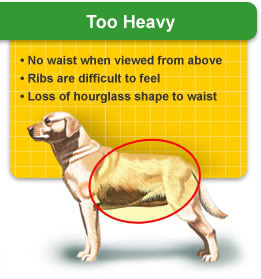 How to Tell If Your Dog is Too Heavy
How to Tell If Your Dog is Too Heavy
- Stand above your dog. Start at the head and work your way back to the tail region. Does the neck seem too wide for your pets head? The head and neck should be close to the same width. Stocky breeds such as Pugs and Bulldogs may seem to have no neck. Next, look at the chest. Does it seem to be disproportionately large when compared to the size of your pets head?A tiny head attached to a broad body signals too much fat. Continue your observation rearward to the hips. Look down and see if your dog has a waist, that is, an invisible indentation behind the ribs. You want to see an hourglass figure, with the rib cage wider than the abdomen. Do you see one large mass from shoulders to hips that gradually gets wider and wider. In people terms this would be pear shaped figure. Some pets have a thin chest and wide stomach region, which is is perhaps the most dangerous figure to have because of the presence of intra-abdominal or belly fat. If your pet is too wide in the belly region, it’s time to act quickly. The stomach should be “tucked up”, not loose and flabby.
- Have your dog stand up and view your dog from the side. Start at the front. Is the neck and shoulder region disproportionately large compared to your dog’s head? Do you see rolls of fat and fur around the neck? Study the chest and abdomen. In lean pets, the chest should be wider than the stomach when viewed from the side. You should see a gradual sloping of the body as you look toward the hips. If the abdomen or stomach region hangs lower or is wider than the chest, your pet is too heavy. In fact, this is a disturbing sign because it indicates that your pet may have an excess of the most dangerous type of fat present in the body, abdominal or belly fat. As you continue viewing your pet from the side, look at the size of the legs relative to the body. Do they appear to be toothpicks, especially when compared to the torso? Many times you can gauze your pets weight and fitness by the amount of muscles and size of their legs, especially the rear legs. Too often we see plump pooches perched on precarious planks. Also note if your pet is leaning forward or backward. Most normal, healthy pets have a slight rearward slope to their body, which means they are carrying more of their weight on their larger and stronger hind legs than they are on their front legs. If your pet is shifting it’s weight forward, this could indicate a discomfort in the knees, hips, or lower back. Some dogs with severe arthritic hip or knee pain will shift almost all of their weight to the front legs.
- View Your Dog from the Rear. Study your pet from the rear as it continues to stand upright. Do you get a sense that your pet is too wide for their legs? many times you”ll see bulging at the hips and chest. A lean, healthy pet should look sleek and streamlined when viewed from the rear. Any bulging that you see should be from the upper legs, and not the hip and lower back region. If your pet looks like a hot dog on a stick, it’s probably not at a healthy weight.
- Feel Your Pet. With your pet still standing, feel the ribs. You should be able to easily feel and count your pet’s ribs. In very lean, muscular, fit pets, you may even see the faint outline of 3 or 4 ribs. If you can’t easily feel your pet’s ribs, or if you feel a roll of fat, this is the single, easiest way to tell if your pet is fat. What about the shoulder blades? Can you feel them without applying much pressure? You should be able to feel the outline of the shoulder blades just as easily as you felt the outline of the ribs. Next, feel your pet’s stomach. Can you grab a handful of flesh? Is the belly’s loose end sagging? A healthy pet will have a somewhat firm stomach with a thin layer of fat covering the abdominal muscle wall. Now feel on your pet’s spine. Can you easily make out each vertebrae? You should be able to feel the gentle rise and fall of each vertebrae as you work your way down the spine. Do you notice rolls of fat on either side of your dog’s backbone? In normal weight pets, you should be able to feel each spine when you rum your fingers down the backbone as well as the adjacent core muscles on either side of the backbone. What about the hips? Can you feel the hip bones easily? If the hip bones are buried under mounds of fat, this indicates a problem. Generally speaking, as a dog’s body size increases, the hips become narrower.
All of this does not mean your pet should be bony and thin. A walking skeleton wagging it’s tail is not a healthy weight. Dog’s should have some fat, which is used both as an energy source and protection. This means that your pet should be lean and muscular. Dogs are incredibly efficient aerobic creature. They evolved as scavengers that could travel great distances in search of food. Carrying too much extra weight put them at a disadvantage from an endurance perspective or from the ability to flee from predators at high speeds. Today’s pet neither hunts for their own food or fears being eaten, but as good pet parents we need to ensure that we maintain a healthy weight for our four legged family members.
Did you ever notice fat owners have fat dogs? I see a pattern here?
Calculate Your Pet’s Body Condition Score (BCS). Here is a simplified way to assess your pet’s BCS:
- Emaciated-Too Thin-Ribs, spine and bony protrusions are easily seen at a distance. These pets have lost muscle mass, and there is no observable body fat. Bony and starved in appearance.
- Thin-Normal-Ribs, spine and other bones are easily felt. These pets have an obvious waist when viewed from above and an abdominal tuck. Lean or skinny in appearance.
- Normal-Ribs and spine are easily felt but not seen. There is a waist when viewed from above, and the abdomen is raised and not sagging when viewed from the side. Ideal and often muscular in appearance.
- Overweight-Ribs and spine are hard to feel or count underneath fat deposits. Waist is distended or often pear shaped when viewed from above. The abdomen sags when seen from the side. There are typically fat deposits on the hips, base of tail, and chest. Heavy, husky or stout.
- Obese-Large fat deposits over the chest, back, tail base and hindquarters. The abdomen sags prominently, and there is no waist when seen from above. The chest and abdomen often appear distended or swollen.
Rule Out A Medical Condition
Not all dogs are overweight because they are overfed or under exercised. The vast majority are, however you must first rule out medical conditions. Hypothyroidism- The most common disease that contributes to excess weight in dogs is hypothyroidism or thyroid hormone production. It most typically effects purebred, middle-aged dogs, ages 4-10, but may affect dogs as young as one year old. It typically manifests in mid to large size breeds (Golden Retrievers, Cocker Spaniels) and is rare in toy and miniature breeds such as (Chihuahuas and Pomeranians). Female dogs are more likely to develop it.
Hypothyroidism- The most common disease that contributes to excess weight in dogs is hypothyroidism or thyroid hormone production. It most typically effects purebred, middle-aged dogs, ages 4-10, but may affect dogs as young as one year old. It typically manifests in mid to large size breeds (Golden Retrievers, Cocker Spaniels) and is rare in toy and miniature breeds such as (Chihuahuas and Pomeranians). Female dogs are more likely to develop it.
Common clinical signs of hypothyroidism are “heat seekers” or cold intolerance, weight gain despite normal food intake, hair loss, especially down the sides of the body, dry skin and coat, lethargy, mental dullness, poor wound healing, increased skin infections, slow hair growth, loss of hair on the tail, known as rat tail, high cholesterol, darkly pigmented areas of the skin and dull hair that pulls out easily.
A dog displaying any of these clinical signs and that is overweight or obese should be evaluated for hypothyroidism. An overweight or obese dog without these clinical signs does not commonly have hypothyroidism.
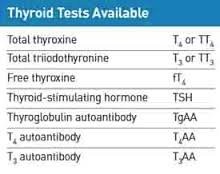 Diagnostic Tests:
Diagnostic Tests:
Total thyroxine (TT4)
Free T4 by Equilibrium Dialysis (ED)
Thyroid stimulating hormone (TSH)
Anti thyroglobulin antibodies
Total cholesterol
Serum chemistries
Complete cell count
 Cushing’s Disease-Cushing’s disease is fairly common in humans, dogs and horses and contributes to weight gain in these species by a variety of mechanisms. It involves excessive production of the hormone cortisol, resulting in increases in blood pressure, blood sugar, and heart and respiratory rates.
Cushing’s Disease-Cushing’s disease is fairly common in humans, dogs and horses and contributes to weight gain in these species by a variety of mechanisms. It involves excessive production of the hormone cortisol, resulting in increases in blood pressure, blood sugar, and heart and respiratory rates.
About 90% of the time in dogs, Cushing’s results from a benign tumor of the pituitary gland. The remaining 10% of cases are caused by a malignant tumor of the adrenal gland.
It most commonly effects middle aged and older dogs, although dogs as young as 6 months old have been reported with it. Breeds such as Poodles, Dachshunds, Schaunzers, Boston terriers and Boxers have a higher incidence.
One of the most reported clinical signs of Cushing’s is increased appetite. In fact, when treating Cushing’s disease, veterinarians often watch for decreasing appetite as a sign that treatment is working.
Common clinical signs of Cushing’s disease are increased appetite, potbelly abdomen, a stomach that appears to be swollen and distended, increased thirst and urination, chronic skin infections, symmetrical hair loss along the sides of the body, thin skin that may tear easily, muscle weakness and loss, cranial cruciate ligament injuries, darkly pigmented areas of skin, calcium deposits in skin, panting, reproductive problems, neurological signs may develop with large pituitary tumors and anal tumors.
Treatment of Cushing’s is far from clear cut. Several medications are available with many treatment protocols offered. Treatment should be based on your dogs specific needs and your veterinarians recommendations, which can vary from surgery to radiation to daily medications.

 Stress-While we don’t often consider our dogs to experience stress, they do. Stress can come in the form of separation anxiety when they’re left alone during the day, unusual environmental stimuli such as strange odors and noises, aggression between two pets or lack of exercise. Stress causes overeating due to excessive secretion of the hormone cortisol. We can identify stress in dogs by noting their body language. Here are some common indicators to look for.
Stress-While we don’t often consider our dogs to experience stress, they do. Stress can come in the form of separation anxiety when they’re left alone during the day, unusual environmental stimuli such as strange odors and noises, aggression between two pets or lack of exercise. Stress causes overeating due to excessive secretion of the hormone cortisol. We can identify stress in dogs by noting their body language. Here are some common indicators to look for.
- Inability to calm down
- Scratching
- Biting Himself
- Biting and chewing furniture, shoes and other things
- Barking, howling, whining
- Diarrhea
- Smell-body or mouth giving off a bad odor
- Tense muscles
- Shaking
- Change of eye color
- Licking himself
- Tail chasing
- Fur that seems to be hard, breakable, standing on end
- Generally looking unhealthy
- Panting
- Losing concentration-inability to concentrate for more than a very short time
- Shivering
- Loss of appetite
- Going to the bathroom more than normal
- Allergies-many allergies are really stress scratching
- Fixation on certain things, flies, light,etc.
- Looking nervous
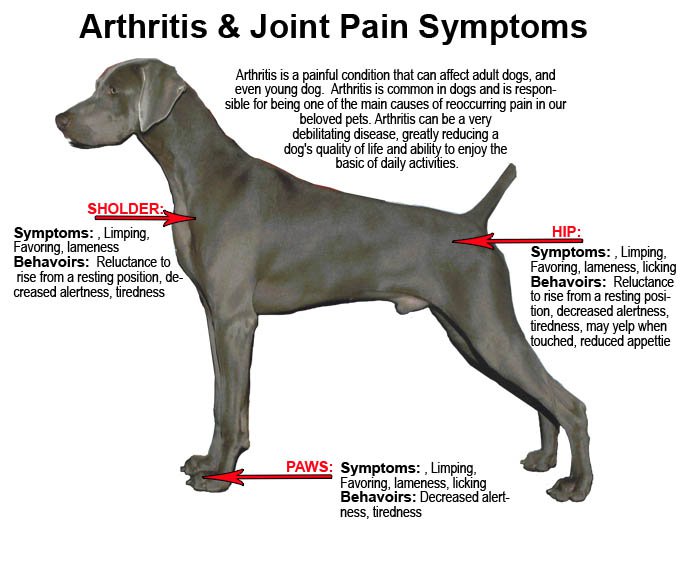 Arthritis-Excess weight can lead to osteoarthritis, but arthritis can lead to obesity. A dog that has painful hips or elbows will be less likely to participate in aerobic activities such as walking or playing, resulting in fat accumulation if the diet is not closely controlled. Breeds that are likely to have congenital hip or elbow dysplaysia include Labrador and Golden retrievers, Belgian malinois, Belgian and German shepherds, Rottweilers, St. Bernards, Shetland sheepdogs, Chinese Shar-pei and many other large breed dogs. Keep in mind if your dog has arthritis, decreased physical activity can lead to obesity, which worsens not only the osteoarthritis but contributes to many other secondary conditions.
Arthritis-Excess weight can lead to osteoarthritis, but arthritis can lead to obesity. A dog that has painful hips or elbows will be less likely to participate in aerobic activities such as walking or playing, resulting in fat accumulation if the diet is not closely controlled. Breeds that are likely to have congenital hip or elbow dysplaysia include Labrador and Golden retrievers, Belgian malinois, Belgian and German shepherds, Rottweilers, St. Bernards, Shetland sheepdogs, Chinese Shar-pei and many other large breed dogs. Keep in mind if your dog has arthritis, decreased physical activity can lead to obesity, which worsens not only the osteoarthritis but contributes to many other secondary conditions.

Respiratory Conditions-A dog suffering from respiratory conditions often struggles to perform even basic aerobic activities. Whenever a dog exercises less, any extra energy is stored as fat. Respiratory disease in overweight dogs is a frustrating circumstance, however maintaining a healthy weight can keep respiratory disease at bay. Dogs born with certain conditions or older dogs that develop breathing disorders require special attention.
One of the most common causes of respiratory weight gain involves brachycephalic respiratory syndrome. The term brachycephalic literally means short head, many of these dogs have a pushed in or squashed face. (Pugs, Boston terriers, Pekingese, Boxers, Bulldogs, Shi Tzus, and any dog with a short, flat nose, protruding or bulging eyes, and short, round face are at risk.
These dogs usually snore and snort, and otherwise have noisy, labored breathing. Because these dogs struggle to breathe, they either self limit their activity or their owners are reluctant to exercise them because of the respiratory distress they observe during walk or play. Either way, these dogs don’t exercise enough and typically start adding pounds at a young age, further worsening their repiratory condition. These dogs are also prone to over heating and heat stroke.
Older dogs with respiratory disease that limit air intake are also more likely to put on extra pounds. Any condition that limits a dogs ability to breathe will result in decreased activity.
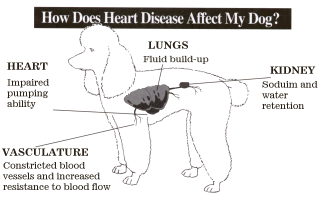
Heart Disease-Heart disease causes weight gain in the same manner as arthritis or respiratory disease-a decrease in the ability to exercise. Many dogs with heart disease develop breathing problems, further reducing their ability to exercise or go for walks. Exercise and weight reduction are critical components in the treatment of heart disease, and dogs should be encouraged to walk or participate in other low impact activities. Right sided congestive heart failure can result in the accumulation of fluid in the abdominal cavity, a condition known as ascites.
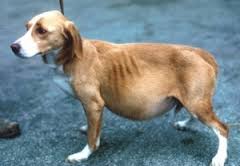

Ascites-Ascites is the medical term for the accumulation of fluid in the belly. If your dogs abdomen or belly begins to swell despite a normal or decreased appetite, contact your veterinarian. You may be able to feel fluid sloshing around the belly if you lightly thump it with your hand.The fluid that is deposited in the belly is usually the result of liver or heart disease, although many diseases,although many diseases may cause ascites in dogs. Treatment varies based on the cause, and has variable outcomes. Ascites needs to be treated as soon as possible before irreversable damage occurs.
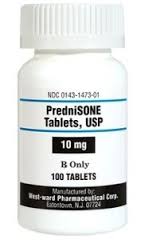 Medications-Certain drugs can cause your dog to gain weight. Phenobarbital(an anti-seizure medicine) and steroids, (prednisone, methylprednisone, ect) are two of the most common medications associated with excess weight. Behavior modification drugs such as Elavil (amitriptyline) and Prozac/Reconcile (fluoxetine) can lead to unwanted pounds. The high blood pressure medication propranolol may also cause weight gain in certain dogs.
Medications-Certain drugs can cause your dog to gain weight. Phenobarbital(an anti-seizure medicine) and steroids, (prednisone, methylprednisone, ect) are two of the most common medications associated with excess weight. Behavior modification drugs such as Elavil (amitriptyline) and Prozac/Reconcile (fluoxetine) can lead to unwanted pounds. The high blood pressure medication propranolol may also cause weight gain in certain dogs.
Once you’ve ruled out a medical problem, you can safely devise your weight loss strategy, beginning with setting realistic goals, calculating your dogs daily calories, and then choosing a weight loss strategy.
Ernie Ward DVM
Turid Rugaas






